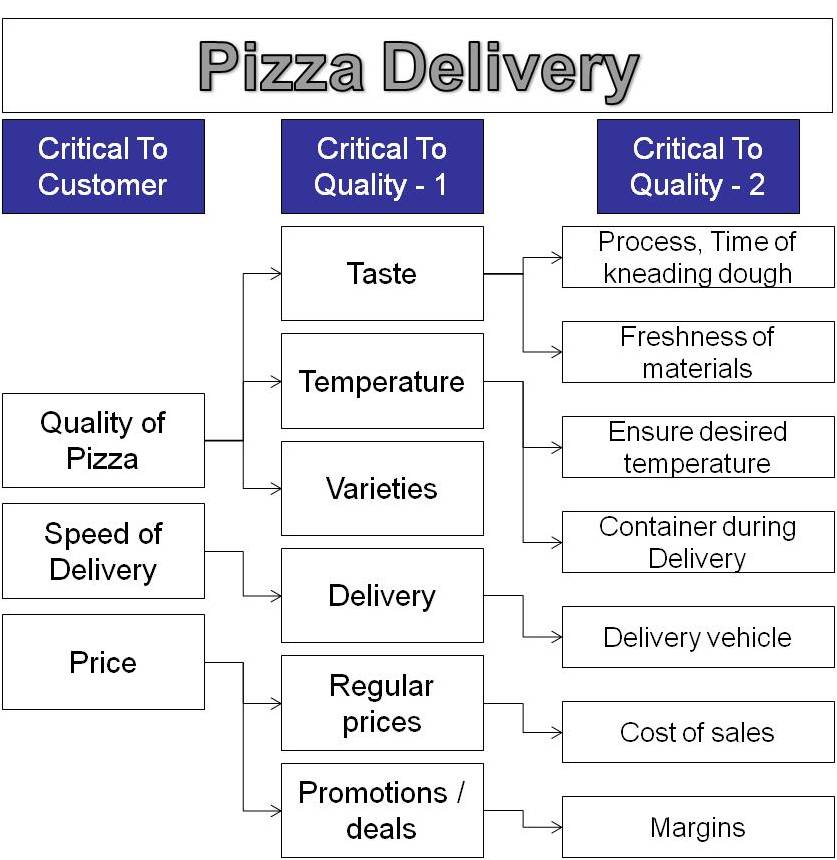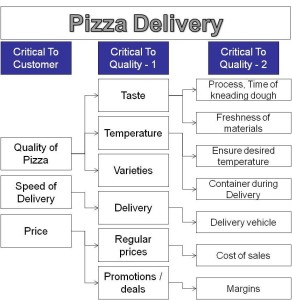
For, any executive who is serious about operational excellence, is handicapped if s/he is not using this concept in some shape or form. CTQs are the internal critical quality parameters that relate to the requirements of the customer. CTQ is the quality, for which customer pays. It links internal processes to the requirements or needs of the customer. They are not the same as CTCs (Critical to Customer), though the two are often confused. CTCs are what is important to the customer; CTQs are what’s important to the quality of the process or service to ensure the things that are important to the customer are delivered without fail. For instance, the sound made by closing a car door might be a CTC, while the dimensional tolerances and cushioning needed to produce those conditions are CTQs for the auto maker. (http://www.isixsigma.com/dictionary/critical-to-quality-ctq/). In Six Sigma, a quality function deployment (QFD) or CTQ tree is used to map the CTQs to the CTCs.
Of course, this post is not intended to be a primer for CTQ. You will find plenty of that on various six sigma websites. Rather, the idea is highlight and open up for discussion the power of the CTQ in our search for Operations Excellence. As I said above, CTQ is often used to identify the changes that need to be made in a process to meet customer requirements better, faster, cheaper. It is typically treated as relatively static — unless of course customer requirements themselves change. That’s plain vanilla.
I believe, however, the power of the concept is released — and better realized — when it is treated dynamically. What I mean is that Operations Executives need to take the C more literally. In a dynamic / fast moving environment, whether on the factory floor or in an office, operations tend to lag and lead on different factors resulting in higher variability in output. For example, after an attack of employee attrition, when the floor is manned by newbies, certain types of errors may be seen more often. Alternatively, when a different brand of input / raw material is used in a process, it may have an unintended impact on the output. Such factors are then required to be managed more closely and, possibly, other changes made in the process, other inputs or even in customer expectations to restore normalcy, or stabilize the process.
In such situations, it is highly recommended that the CTQs be revisited. Yes, the CTC has not changed. But the change in inputs or their sources has impacted output and unless the focus of operations is shifs, it is not possible to bring the process back on track. It is in such circumstances that one needs to consider a change in CTQs — even though the customers or their CTCs have not changed.
Another opportunity to change your CTQ occurs when you want to move from customer satisfaction to customer delight. Assume you have already accomplished customer satisfaction and are now looking to delight your customers with new features or a richer experience (which, the customer may not have specifically required). It would be best to revisit your CTQs at this stage; this time, along with identifying the new feature as a CTC.
I believe this is what justifies using the term “critical”. The specific dictionary meaning I would pick for this term in this context would be “of or forming a crisis; crucial; decisive: a critical operation” and “urgently needed: critical medical supplies“. The point is that changed circumstances have made something else critical today. To bring the same process focus on to the impact of such change, it is important to identify its impact on the output, customer satisfaction and identify different CTQs to focus on.
Of course, the job does not end with identifying the new CTQ. What it does is to focus organizational energy on the new CTQ, which gets measured, highlighted and worked upon. Going back to the example of newbies on the floor, changing the CTQ to, say, “compliance with internal guidelines”, will enable a sharper focus on measuring variance vis-a-vis compliance guidelines and enable introduction of re-training, poka-yokes, huddles and the like to ensure the process reverts to normalcy.
To sum up, CTQs work best when they are revisited occasionally — especially when there are other changes in inputs or suppliers, or when Management decides on adding higher value to the output.
— Sri
SigMax-e


Thanks for sharing this useful info. Keep updating same way.
Regards, AshishChange Management
Very clear thoughts on CTQ, helped to understand the concept better.
Thank you.